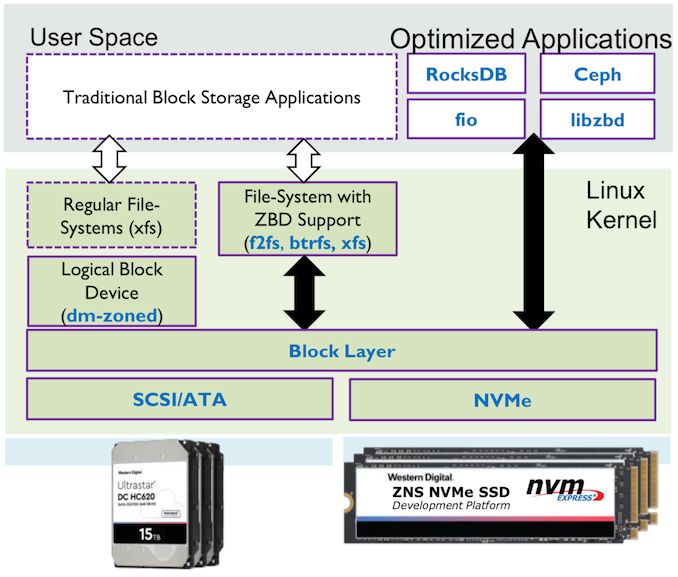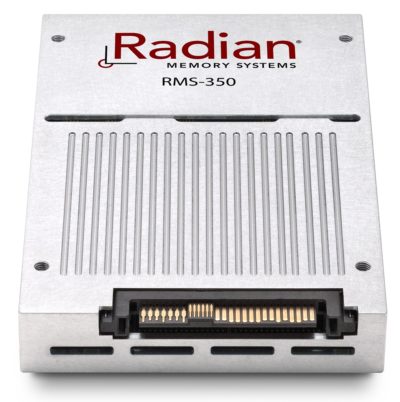The Next Step in SSD Evolution: NVMe Zoned Namespaces Explained
by Billy Tallis on August 6, 2020 12:00 PM EST- Posted in
- SSDs
- Storage
- Western Digital
- NVMe
- SMR
- Radian Memory
Ecosystem Status: Users and Use Cases
The software changes required, both in firmware and OS support/software, will keep zoned SSDs in the datacenter for the foreseeable future. Most of the early interest and adoption will be with the largest cloud computing companies that have the resources to optimize their software stacks top to bottom for zoned storage. But a lot of software work has already been done: software targeting host-managed SMR hard drives or open-channel SSDs can be easily extended to also support zoned SSDs. This includes both applications and filesystem drivers that have been modified to work on devices that do not support in-place modification of data.
Linux Kernel version 5.9 will update the NVMe driver with ZNS support, which plugs in to the existing zoned block device framework. Multiple Linux filesystems either already support running directly on zoned devices, or such support has been developed but not yet merged into a stable kernel release. The device mapper framework already includes a component to emulate a regular block device on top of a zoned device like a ZNS SSD, so unmodified filesystems and applications can be used. Western Digital has released a userspace library to help applications interact directly with zoned devices without using one of the kernel's filesystems on the device.
Only a few applications have publicly released support for ZNS SSDs. The Ceph clustered storage system has a backend that supports zoned storage, including ZNS SSDs. Western Digital has developed a zoned storage backend for the RocksDB key-value database (itself used by Ceph), but the patches are still a work in progress. Samsung has released a cross-platform library for accessing NVMe devices, with support for ZNS SSDs. They've written their own RocksDB backend using this library. As with host-managed SMR hard drives, most production use of ZNS (at least early on) will be behind the scenes in large datacenters. Because ZNS gives the host system a great degree of control over data placement on the SSD, it allows for good isolation of competing tasks. This makes it easier to ensure good storage performance QoS in multi-tenant cloud environments, but the relative lack of zone-aware software means there isn't much demand for such a hosting environment yet.
The most enthusiastic and prolific supporter of ZNS and zoned storage in general has been Western Digital, which stands to benefit from the overlap between ZNS and SMR hard drives. But it is very much a multi-vendor effort. The ZNS standard lists authors from all the other major NAND flash manufacturers (Samsung, Intel, Micron, SK Hynix, Kioxia), controller vendors (Microchip), cloud computing hyperscalers (Microsoft, Alibaba), and other familiar names like Seagate, Oracle and NetApp.
Longtime zoned SSD provider Radian Memory recently published a case study conducted with IBM Research. They ported an existing software-based log-structured storage system to run on Radian's non-standard zoned SSDs, and measured significant improvements to throughput, QoS and write amplification compared to running on a block storage SSD.
Most SSD vendors have not yet announced production models supporting ZNS (Radian Memory being the exception), so it's hard to tell what market segments, capacities and form factors will be most common among ZNS SSDs. The most compelling opportunity is probably for ZNS-only QLC based drives with reduced DRAM and overprovisioning, but the earliest models to market will probably be more conventional hardware configurations with updated firmware supporting ZNS.
Overall, ZNS is one of the next steps in mirroring the use of SSDs in the way SSDs are actually designed, rather than an add-on to hard drive methodology. It is a promising new feature. It looks likely to see more widespread adoption than previous efforts like open-channel SSDs, and the cost and capacity advantages should be more significant than what SMR hard drives have offered relative to CMR hard drives.












45 Comments
View All Comments
jeremyshaw - Monday, August 10, 2020 - link
The early 70s and 80s timeframe saw CPUs and Memory scaling roughly the same, year to year. After a while, memory advanced a whole lot slower, necessitating the multiple tiers of memory we have now, from L1 cache to HDD. Modern CPUs didn't become lots of SRAM with at attached ALU just because CPU designers love throwing their transistor budget into measly megabytes of cache. They became that way, simply because other tiers of memory and storage are just too slow.WorBlux - Wednesday, December 22, 2021 - link
Modern CPU's have instruction that let you skip cache, and then there was SPARC with streaming accelerators, where you could unleash a true vector/CUDA style instruction directly against a massive chunk of memory.Arbie - Thursday, August 6, 2020 - link
An excellent article; readable and interesting even to those (like me) who don't know the tech but with depth for those who do. Right on the AT target.Arbie - Thursday, August 6, 2020 - link
And - I appreciated the "this is important" emphasis so I knew where to pay attention.ads295 - Friday, August 7, 2020 - link
+1 all the waybatyesz - Thursday, August 6, 2020 - link
UltraRAM is the next big step in the computer market.tygrus - Thursday, August 6, 2020 - link
The first 512-sectors I remember is going back to the days of IBM XT compatibles, 5¼ inch floppies, 20MB HDD, MSDOS, FAT12 & FAT16. That well over 30 years of baggage is heavy to carry around. They moved to 32bit based file systems and 4KB blocks/clusters or larger (eg. 64 or 128bit addresses, 2MB blocks/clusters are possible).It wastes space to save small files/fragments in large blocks but it also wastes resources to handle more locations (smaller blocks) with longer addresses taking up more space and processing.
Management becomes more complex to overcome the quirks of HW & increased capacities.
WaltC - Tuesday, August 11, 2020 - link
Years ago, just for fun, I formatted a HD with 1k clusters because I wanted to see how much of a slowdown the increased overhead would create--I remember it being quite pronounced and quickly jumped back to 4k clusters. I was surprised at how much of slow down it created. That was many years ago--I can't even recall what version of Windows I was using at the time...;)Crazyeyeskillah - Thursday, August 6, 2020 - link
I'll ask the dumb questions no one else has posted:What kind of performance numbers will this equate to?
Cheers
Billy Tallis - Thursday, August 6, 2020 - link
There's really too many variables and too little data to give a good answer at this point. Some applications will be really ill-suited to running on zoned storage, and may not gain any performance. Even for applications that are a good fit for zoned storage, the most important benefits may be to latency/QoS metrics that are less straightforward to interpret than throughput.The Radian/IBM Research case study mentioned near the end of the article claims 65% improvement to throughput and 22x improvement to some tail latency metric for a Sysbench MySQL test. That's probably close to best-case numbers.